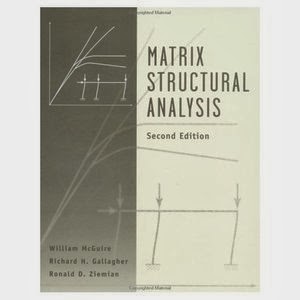As one of the methods of structural analysis, the direct stiffness method, also known as the matrix stiffness method, is particularly suited for computer-automated analysis of complex structures including the statically indeterminate type. It is a matrix method that makes use of the members' stiffness relations for computing member forces and displacements in structures. The direct stiffness method is the most common implementation of the finite element method (FEM). In applying the method, the system must be modeled as a set of simpler, idealized elements interconnected at the nodes. The material stiffness properties of these elements are then, through matrix mathematics, compiled into a single matrix equation which governs the behavior of the entire idealized structure. The structure’s unknown displacements and forces can then be determined by solving this equation. The direct stiffness method forms the basis for most commercial and free source finite element software.
Labels
- 3D printing
- Aerodynamic engineering
- Aeronautical engineering
- Aeronautical engineering books
- Airports
- Architecture
- Artificial intelligence
- Automobiles
- Blast Resistant Design
- Books
- Bridges
- Building Codes
- Cabin Systems
- Civil Engineering
- Codes
- Concrete
- Conferences
- Construction Management
- Construction Materials
- Cooling
- Cryptocurrency
- Dams
- Do it Yourself
- Docks and Harbours
- Downloads
- Earthquake Engineering
- Electronics Engineering
- Engines
- Environmental Design & Construction
- Environmental Engineering
- Estimation
- Fluid Mechanics
- Fluid Mechanics Books
- Formwork design
- foundation engineering
- General
- Geotech Books
- Geotechnical Engineering
- Global Positioning System
- HVAC
- Hydraulics
- Hydraulics Books
- Hydro Power
- Hydrology
- Irrigation Engineering
- Machinery
- Magazines
- Management Books
- Masonry
- Mechanical Engineering
- Mechanics
- Mechanics Books
- Miscellaneous Books
- Modern Steel Construction
- Nanotechnology
- Natural Hazards
- Network Security Engineer
- Networking Systems
- News
- Noise and Attenuation
- Nuclear Engineering
- Nuclear Hazards to Buildings
- Pavement Design
- Prestressed Concrete
- Project Management
- Project Management Books
- Quantity Survey
- Quantity Survey Books
- railways
- RCC Structural Designing
- Remote Sensing
- Remote Sensing and GIS Books
- Renewable Energy
- Reports
- Resume
- Roads
- scholarships
- Smart devices
- Software
- Software Engineering
- Soil Mechanics
- Solar Energy
- Special Concrete
- Spreadsheets
- Steel
- Steel Spreadsheets
- Structural Analyses
- structures
- Structures Books
- Surveying
- Surveying Books
- Testing
- Thermodynamics
- Thesis
- Transportation Books
- Transportation Engineering
- Tunnel Engineering
- Wind Energy
- Zero Energy Buildings
Structures
gridpost/structures
Hot topics
[recent][newsticker]
3D printing
Aerodynamic engineering
Aeronautical engineering
Aeronautical engineering books
Airports
Architecture
Artificial intelligence
Automobiles
Blast Resistant Design
Books
Bridges
Building Codes
Cabin Systems
Civil Engineering
Codes
Concrete
Conferences
Construction Management
Construction Materials
Cooling
Cryptocurrency
Dams
Do it Yourself
Docks and Harbours
Downloads
Earthquake Engineering
Electronics Engineering
Engines
Environmental Design & Construction
Environmental Engineering
Estimation
Fluid Mechanics
Fluid Mechanics Books
Formwork design
foundation engineering
General
Geotech Books
Geotechnical Engineering
Global Positioning System
HVAC
Hydraulics
Hydraulics Books
Hydro Power
Hydrology
Irrigation Engineering
Machinery
Magazines
Management Books
Masonry
Mechanical Engineering
Mechanics
Mechanics Books
Miscellaneous Books
Modern Steel Construction
Nanotechnology
Natural Hazards
Network Security Engineer
Networking Systems
News
Noise and Attenuation
Nuclear Engineering
Nuclear Hazards to Buildings
Pavement Design
Prestressed Concrete
Project Management
Project Management Books
Quantity Survey
Quantity Survey Books
railways
RCC Structural Designing
Remote Sensing
Remote Sensing and GIS Books
Renewable Energy
Reports
Resume
Roads
scholarships
Smart devices
Software
Software Engineering
Soil Mechanics
Solar Energy
Special Concrete
Spreadsheets
Steel
Steel Spreadsheets
Structural Analyses
structures
Structures Books
Surveying
Surveying Books
Testing
Thermodynamics
Thesis
Transportation Books
Transportation Engineering
Tunnel Engineering
Wind Energy
Zero Energy Buildings
Home
Books
Civil Engineering
Structural Analyses
structures
Structures Books
Book: Matrix Structural Analysis by William McGuire
[blogger]
Author Name
Engineeersdaily
Powered by Blogger.

